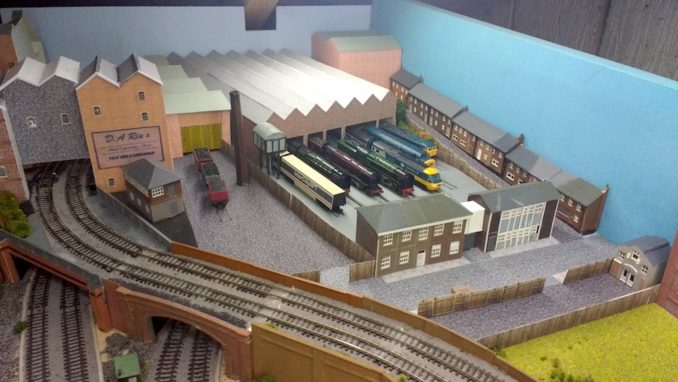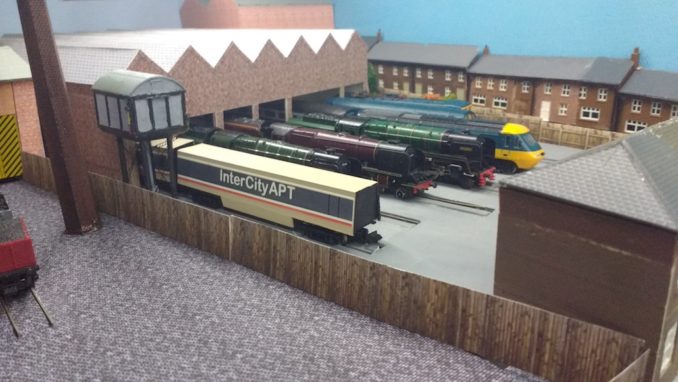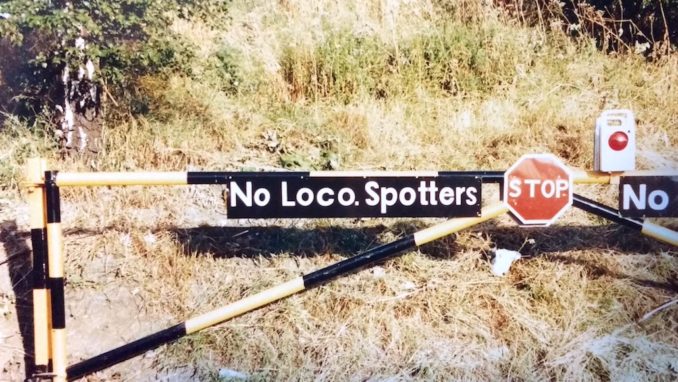I think I told Puffins that my winter hobby day project (when I can’t get into the garden) was an engine shed for my model railway, Charlisle. Based on the old Kingmoor steam shed, long gone, which sat to the right side of the West Coast mainline (known as the Caledinoain mainline to old people like me) just north of Carlisle station, across the River Eden and through the cutting at Etterby. In its heyday, the depot included a coaling plant, ash pits, a heavy repair shop, turntable, signal box, crane shed, offices and a railwayman’s hostel for those in barracks overnight between workings.
The most obvious feature was an eight-road engine shed with an additional two roads running through an adjoining workshop. Originally numbered 12A in the old scheme of things, in the new scheme of things the depot code was KD but this referred to a new diesel depot built on the other side of the tracks at the end of steam. It still stands as the DRS depot. There was also a KM depot code which referred to Kingmoor Marshalling Yard or Carlisle New Yard, or rather its fuelling point which never actually had an allocation of rolling stock.
As ever, space forbade but I was able to build a seven-road shed in the style of Kingmoor with a series of pitched roofs running above each road. This is supported by walls of indented brickwork. To liven up what threatened to be a blocky part of the layout, it is set at an angle and appears to disappear offscreen with the back of the shed’s roof disguising the curve on the top part of the layout. This goes through the backboard and runs along the upper level of the fiddle yard behind. The curve on the lower level is disguised by the upper level on which the engine shed sits.
Scratch built (that means not a kit but designed and made by the modeller) plasticard was cut to the right sizes and glued together before being covered in the coward’s way out – stickie back glossy paper with brickwork and slates printed on. With the angle, those seven roads result in 14 pitched roof sections, all of a different length and all with an angled end that had to sit snug to the backboard. Not as difficult as you might think. CAD calls. I use SketchUp. First, draw your engine shed. Second, draw a plane across one end at an angle and measure up all the resulting dimensions with the tape measure tool. Use a Stanley knife to cut all your pieces out from a plasticard sheet and assemble them with plastic cement glue. You will also use the same measurements to cut out from the of stickie back tiles.

© Always Worth Saying 2022, Going Postal
The base is a layer of grey painted plasticard above a layer of track between more plasticard with another complete sheet of plasticard below making a stout wafer-type structure. The base has to be strong as it will have to be lifted as one section to allow access to the concealed running tracks underneath. The resulting structure is decent but looks too much like a model. More detail needs to be added along with some weathering – next winter’s project. Until then, the depot is operational rather than finished and is called Charlisle Kingmoorville as at one point, the Gods of railways and brick making had me living exactly (to the inch) halfway between Kingmoor depot and the clay pits at Moorville.
The building at the front, beside the cobbled street, is a famous Border City landmark where my father worked, mistakenly assembled the wrong way around. The more modern part should be to the left. Myself and my niece found the prototype on Google Street View despite it having been demolished. She provided a brilliantly proportioned scale stretch from which I was able to take measurements for the model. Incidentally, my father stopped turning in his grave the day we voted to leave the EU but started again as an Aldi began to rise from the rubble of his old workplace. Enough clues. Extra house points for any Puffin who successfully guesses below the line the exact location and whose offices they were.

© Always Worth Saying 2022, Going Postal
Another point of interest is the building on the extreme right. We had a French exchange student stay one summer and he was invited to submit plans for a French Consulate. He took it seriously and, as a Frenchman would, did try to catch me out with lots of curves, windows and columns. I did manage to model it. Obviously, I snapped off the French flags and threw them away the day he left. Apart from that it’s intact but used for storing marmalade since diplomatic relations between Charlisle and France subsequently ended in acrimony. The building to the right is my daughter’s marmalade factory. That is what she asked for. It makes me smile when Liz Trusses people claim she’s a tough cookie who had to fight for everything because she has three older brothers. My daughter has three older brothers and all she has to do is flutter her eyelids and pretend she’s going to cry.
To the left is a private siding, used for different things on different days. At the moment, following a July heat wave which didn’t last long enough for it to be technically defined as a heat wave, it is fulfilling an exacting order for more carbon to be burned. Some coal wagons can be seen on the siding.

© Always Worth Saying 2022, Going Postal
The obvious way to celebrate the opening of the depot would be an open day. The lineup for which is captured in close-up in Picture 3. From left to right;
- 49003 City of Derby APT power car
- 92220 Evening Star BR Standard Class 9F. Last British steam engine built (before the one-off Tornado)
- 70000 Britannia BR Standard Class 7 4-6-2
- 43015 HST set 253007
- 40145 English Electric Type 4 diesel-electric 1-Co-Co-1
- 87101 Stephenson, BREL Class 87 Bo-Bo electric locomotive with thyristor control
Yes, APT 49003 City of Derby, another project. The two Trailer Brake Firsts are also done, one can be seen behind the power car. The two Driving Trailer Seconds are still in their undercoats. The Motor Non-Driving is way too short as it is powered by a Japanese Green Max tram chassis. Rule 1 applies. Made of plasticard, it was painted and finished with self-adhesive stickie back paper transfers of my own design. It is slab-sided compared with the original. With CAD I was able to simplify the shape of the driving car ends and, when painted and with stickies on, the complete set will look spot-on from a distance.
There are plans for unsymmetrical toruses, which will have to be 3D printed, to go around the pin attaching the bodies to the bogies thus making the coaches tilt around corners. Puffins paying attention will have realised all the curves on the layout are concealed anyway. Not the point. Missing from our open day are lots of stalls and people. Perhaps the photographer snook in as it was being set up before the public, stall holders and trade stands arrived? Which reminds me …..

© Always Worth Saying 2022, Going Postal
The Puffin is a smart bird; nicely dressed, always polite, collar and tie, an effortless air of authority. Upon a locked door, he asks a jobsworth to open it. No explanation is needed. Fence? Climb over without making a fuss. No one will notice. Sign saying no loco spotters? Duck under without breaking your stride. If open, walk past. In the 1990s some of the best railway open days were at Old Oak Common in West London on that alien thing known as the Great Western. Given the demographic of such things, I’m sure I wasn’t the only Puffin in attendance though I might have bagged the best photos. Albeit, in the days before photoshop, somewhat cobbled together!

© Always Worth Saying 2022, Going Postal
© Always Worth Saying 2022



